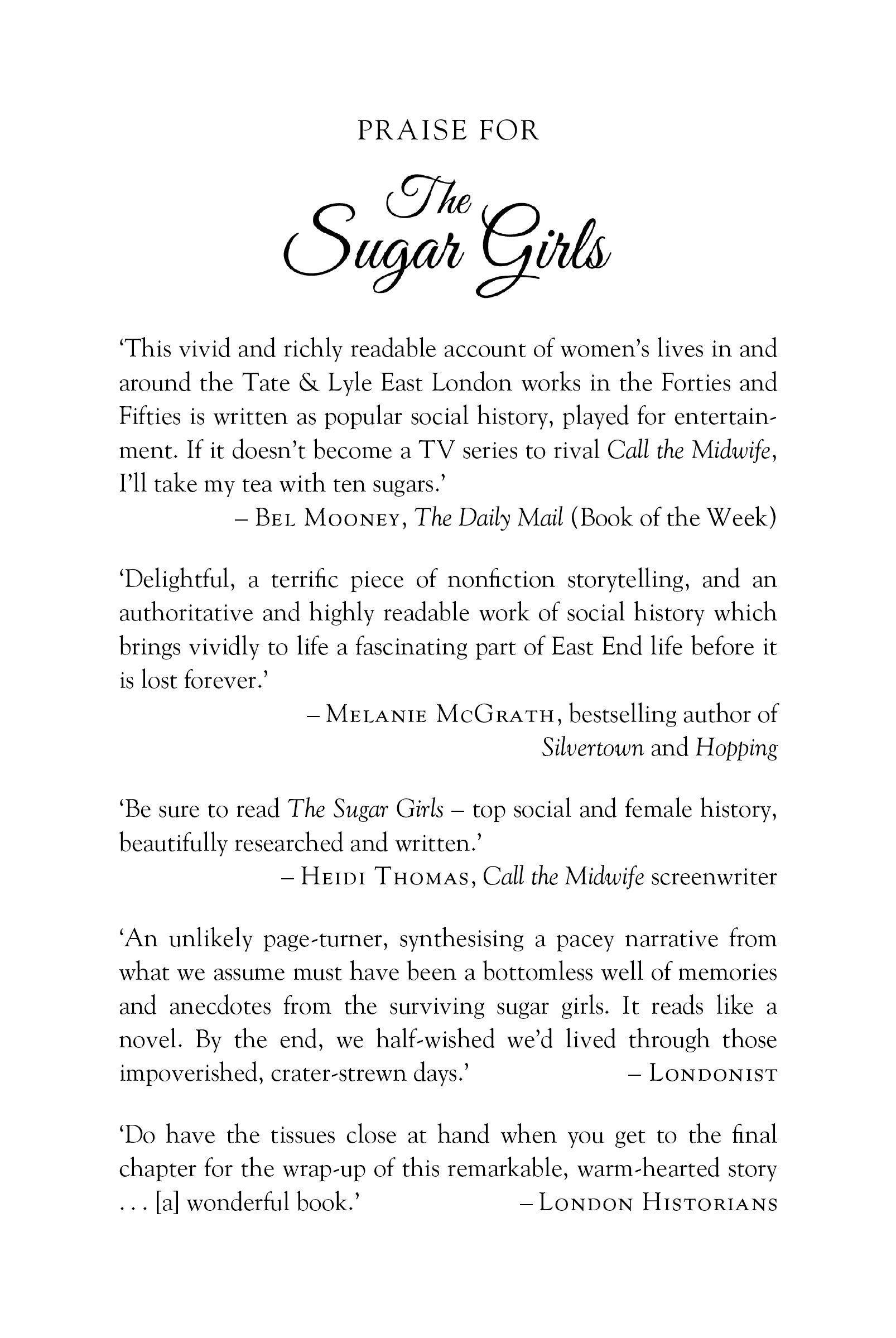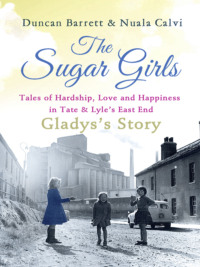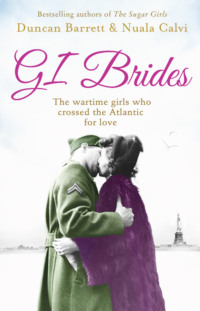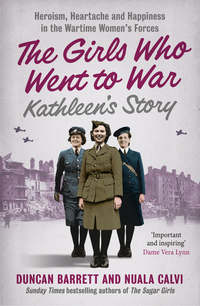
Полная версия
The Girls Who Went to War: Heroism, heartache and happiness in the wartime women’s forces




Copyright
HarperElement
An imprint of HarperCollinsPublishers
1 London Bridge Street
London SE1 9GF
www.harpercollins.co.uk
First published by HarperElement 2015
© Duncan Barrett and Nuala Calvi 2015
Cover layout design © HarperCollinsPublishers Ltd 2015
Cover photographs (not representations of the women portrayed herein) © George W. Hales/Getty Images (WAAF officer); The Everett Collection/Mary Evans Picture Library (military officer); IWM Collection (WRNS officer); London Fire Brigade/Mary Evans Picture Library (background)
Duncan Barrett and Nuala Calvi assert the moral right
to be identified as the authors of this work
A catalogue record of this book is
available from the British Library
All rights reserved under International and Pan-American Copyright Conventions. By payment of the required fees, you have been granted the nonexclusive, non-transferable right to access and read the text of this e-book on screen. No part of this text may be reproduced, transmitted, downloaded, decompiled, reverse engineered, or stored in or introduced into any information storage retrieval system, in any form or by any means, whether electronic or mechanical, now known or hereinafter invented, without the express written permission of HarperCollins e-books.
Find out about HarperCollins and the environment at
www.harpercollins.co.uk/green
Source ISBN: 9780007501229
Ebook Edition © May 2015 ISBN: 9780007501236
Version: 2015-03-17
Dedication
For
Cathleen Alexander (ATS, 1941–1946)
Anne Barrett (ATS, 1943–1944)
and in memory of
Jane Bekhor (WAAF, 1941–1943)
Contents
Cover
Title Page
Praise for The Sugar Girls
Praise for GI Brides
Copyright
Dedication
Preface
1. Jessie
2. Margery
3. Kathleen
4. Jessie
5. Margery
6. Kathleen
7. Jessie
8. Margery
9. Kathleen
10. Jessie
11. Margery
12. Kathleen
13. Jessie
14. Margery
15. Kathleen
16. Jessie
17. Margery
18. Kathleen
19. Jessie
20. Margery
21. Kathleen
Epilogue
Acknowledgements
About the Authors
Exclusive sample chapter
If you like this, you’ll love …
Moving Memoirs eNewsletter
Write for Us
About the Publisher
Preface
In the summer of 1940, Britain stood alone against Germany. One by one, the other Allied nations – France, Belgium, Holland, Norway, Denmark and Poland – had all surrendered, and America and the Soviet Union were yet to join the war. But for all the brave talk of fighting the enemy on the beaches, the country was outgunned – and outmanned as well. The British Army stood at just over one and a half million men, while the Germans had three times that many, plus a population almost twice the size of Britain’s from which to draw new waves of soldiers.
Clearly, in the fight against Hitler, manpower alone wasn’t going to be enough.
During the First World War, all three branches of the British military had formed a female auxiliary service, but the new organisations had been mothballed soon after hostilities came to a close. In the build-up to a second global conflict they were hastily recalled to life, and it was now that the women’s forces really came into their own.
Initially, both the Army and the RAF were supported by the Auxiliary Territorial Service, or ATS, but two months before Britain declared war on Germany in 1939, the Women’s Auxiliary Air Force (WAAF) split off and became a separate organisation. Fulfilling an equivalent role in relation to the Navy was the Women’s Royal Naval Service. Among the women’s forces, the WRNS was considered the ‘senior service’, just as the Navy was among the three male forces. Its members – thanks to its unwieldy acronym – were known as ‘Wrens’.
In fact, settling on a suitable name for the organisation had proved quite a minefield. It came close to being christened the Women’s Auxiliary Naval Corps, until someone realised that the abbreviation ‘WANC’ might provoke jibes from the sailors its members worked alongside.
Of the three services, the WRNS was generally regarded as the classiest, and was by far the hardest to get in to, unless you had the right naval connections. Being a Wren was seen as rather glamorous, in part thanks to the distinctive navy blue uniform, which had been designed by the celebrated couturier Edward Molyneux. While the WAAF and ATS outfits featured belted waists and pleated pockets that were unflattering on the hips, the WRNS jacket was straight and streamlined, and the officer’s tricorne hat was much admired. To top it off, the Navy girls were even allowed to wear black silk stockings – when asked why he had permitted such extravagance, the First Lord of the Admiralty joked, ‘The Wrens like the feel of them, and so do my sailors.’
By the time war was actually declared in September 1939, all three of the women’s services had been deluged with applicants, and tens of thousands of young women were soon donning their distinctive new uniforms – khaki for the ATS, Air Force blue for the WAAF, and navy for the WRNS. When conscription for women was introduced in the National Service Act of 1941, the ranks of the services were swelled further, as many girls chose the rigours of military life over hazardous work in a munitions factory or the hard labour of tilling the fields with the Land Army. There were some who refused to be drafted – 257 female conscientious objectors found themselves imprisoned as a result of their principles – but most girls reported for duty reasonably willingly and did their best to fit into life in the forces, however alien the military environment might seem to them.
In many ways, the girls in uniform were aspirational figures, and during the war their image was appropriated by advertisers keen to appeal to young, independent-minded women. But they were far from universally popular. Old sweats in the military were often mistrustful of their new colleagues, and anxious about sharing facilities with them. One veteran RAF officer told the BBC of his horror at the thought of ‘petticoats’ on his air base, and General Eisenhower himself was initially opposed to working alongside women, although the competence and professionalism he saw at his HQ in London were enough to make him change his mind.
Some men, whether military or civilian, feared that girls in uniform were getting ideas above their station. ‘The menace,’ fumed one magazine editor, ‘is the woman who thinks she ought to be flying a high-speed bomber when she really has not the intelligence to scrub the floor of a hospital properly, or who wants to nose around as an air-raid warden and yet can’t cook her husband’s dinner.’ Others complained that servicewomen were encroaching into previously male-dominated spaces – most shocking of all, they were seen accepting drinks from strangers in pubs.
The government attempted to calm the male population with a pamphlet that asserted reassuringly, ‘The girls look healthy and happy, and clearly most of them will make better wives and mothers and citizens, if only because they have had some physical and mental training.’ But many British people – men and women alike – were unconvinced. The confidence that many girls exuded when they put on a military uniform was seen by some as unladylike, and they were frequently accused of having loose morals – in fact many civilians fervently believed that women in the forces were little more than prostitutes. In popular slang, the letters ATS were said to stand for a number of lewd expressions, from ‘Any time, Sergeant!’ to ‘American Tail Supply’. Army girls were referred to colloquially as ‘officers’ groundsheets’, while WAAFs were labelled ‘pilots’ cockpits’ and the girls in the Navy were the butt of a popular expression – ‘Up with the lark and to bed with a Wren.’
The tabloid press didn’t help matters. ‘TOO MANY MISFITS IN THE ATS AND WAAF,’ thundered the Express, while the Daily Mail ran a poll on what their readers hated most about the war, in which ‘women in uniform’ came top.
Such was the strength of feeling among the public that Parliament set up a committee to look into the alleged moral failings of the women’s forces. In August 1942 the social reformer Violet Markham reported confidently that the accusations levelled against the girls were groundless. Although some servicewomen had been discharged for illegitimate pregnancies – in the ATS this was known as ‘going para 11’, after the section of the rulebook that dealt with such cases – the illegitimate birth rate in the services was in fact lower than among the civilian population at the time, and the rate of venereal disease among servicewomen was half that among men.
It seems particularly unfair that so many civilians looked down on the girls in uniform, since the part they played in winning the war was a crucial one. Without the contribution made by the WAAF, for example, the Royal Air Force would have needed an extra 150,000 men – a figure all but impossible to muster. And although the girls of the three forces were forbidden by Royal Proclamation from personally firing deadly weapons, they were closely involved in many of the key events of the war, and frequently found themselves in harm’s way. In 1940, ATS ambulance drivers serving with the British Expeditionary Force in France were caught up in the frantic rush to evacuate at Dunkirk. Four years later, WAAF medical orderlies were among the first women to return to Europe after D-Day – when their air ambulances landed in Normandy just a week after the invasion, they were hailed as ‘Angels of Mercy’.
Many servicewomen won medals for their bravery in terrifying circumstances – among them Daphne Pearson, who dragged a pilot out of his crashed plane just before a bomb exploded, hurling herself on top of him to shield his body from the blast. Others made critical contributions to Allied operations, such as Constance Babbington Smith, the first person to locate the launch sites of Hitler’s deadly V1 flying bombs. Girls from all three forces worked under top-secret conditions at Bletchley Park, helping to shorten the war by at least two years – Churchill later referred to them as ‘the geese that laid the golden eggs but never clucked’.
Then there were the courageous young women who shed their military uniforms when they were transferred to the Special Operations Executive, a spy network whose operatives were trained to kill with guns and explosives, and whose life expectancy in occupied Europe could be measured in weeks. Among them was former WAAF Noor Inayat Khan, who, after her comrades in the field were arrested, found herself the only link between a resistance network in Paris and the Allied command in London. In time she too was captured and taken to Dachau concentration camp, where she was executed with a bullet to the head.
Throughout the course of the war, around two thousand WAAFs, Wrens and ATS girls lost their lives in the service of their country. Some died on their bases around Britain, the victims of enemy bombing raids. Some were buried in foreign fields far away from home – in Cairo, Kuala Lumpur or Tel Aviv. Others were lost at sea, among them the 23 Wrens who drowned when the SS Aguila was sunk in the first U-boat attack on an Allied shipping convoy.
Overall, more than half a million women served in the armed forces during the Second World War. This book tells the stories of just three of them – one from the Army, one from the Navy and one from the Air Force. But in their stories are reflected the lives of hundreds of thousands of others like them – ordinary girls who went to war, wearing their uniforms with pride.
1
Jessie
The morning of Sunday 3 September 1939 was a sunny one, and Jessie Ward was out digging potatoes in the garden of her family’s house in the little village of Holbeach Bank, Lincolnshire. A petite girl with big blue eyes and dark hair, she looked far younger than her 17 years, but despite her slight build her mother always made sure to keep her busy with chores. That particular day Mrs Ward was looking after a sick friend’s little girl, so Jessie had even more to do than usual.
Just after 11 o’clock that morning, Mr Ward called his wife and daughter into the living-room, where they found him listening intently to the bulky wooden wireless set. There was a crackle, and then the clipped tones of Neville Chamberlain rang out of the machine. ‘This morning,’ he announced, ‘the British Ambassador in Berlin handed the German Government a final note, stating that, unless we heard from them by 11 o’clock that they were prepared at once to withdraw their troops from Poland, a state of war would exist between us.’
Jessie saw her mother and father exchange an anxious glance.
‘I have to tell you now,’ the Prime Minister continued, ‘that no such undertaking has been received, and that consequently this country is at war with Germany.’
Mr Ward leaned forward, holding his head in his hands. ‘It can’t happen again,’ he muttered. ‘It just can’t.’ Jessie knew that her father had spent much of the last war watching his fellow soldiers in the Royal Warwicks being gassed and slaughtered in front of him, and had witnessed his best friend being shot in the head.
‘Well, we’ll probably be invaded, being so close to the coast,’ said his tiny wife, matter-of-factly. ‘I’d better take Tina back to her mother. Jessie, you’ll have to do the Sunday dinner.’
‘Yes, Mum,’ Jessie replied, as the little girl began to howl. Whether it was because of the imminent invasion, or because she was missing dinner, Jessie wasn’t sure, but she was surprised to find that she herself felt nothing at all. Unlike her father, she had little idea of what war might bring, since the last one had ended four years before she was born.
Jessie went back out into the garden, and nodded over the fence at Mr Crawford, the elderly man who lived next door. ‘Do you think we’ll be invaded?’ she asked him.
‘Oh, don’t worry,’ he told her. ‘Even if we are, the Germans aren’t going to hurt the likes of us.’
Jessie’s father came marching out into the garden just in time to catch Mr Crawford’s remark. ‘You silly bugger!’ he shouted. ‘You’re the first ones the Nazis’ll get rid of. Your wife is blind and you’re an old man!’
‘They wouldn’t do that,’ Mr Crawford protested weakly.
‘They would,’ retorted Mr Ward. ‘I know the Germans. They wouldn’t waste food on people like you!’
Jessie was shocked – not so much by her father’s anger, or by the grim prophecy in his words, but at the fact that he had said ‘bugger’. She realised she had never heard him swear before.
In fact, it was rare to hear Mr Ward raise his voice at all, other than where Germans were concerned. He was a kindly man, whose health had never been the same since he had returned from the trenches 20 years earlier. It didn’t help that he had to work six days a week, hammering away in his little cobbler’s shop – and keeping it open until 9 p.m. most nights for the sake of the local farm labourers. Most of his customers only had one pair of dilapidated old boots to their name, but Mr Ward would work miracles on them, knowing that their owners couldn’t afford to buy new ones.
While Jessie’s father was out working all hours, his wife had free rein to boss their only daughter around. Fanny Ward was small, pretty woman, but her demure exterior belied a sharp temper, and Jessie had learned from a young age never to displease her. Every time she dropped a ball of wool she was winding or accidentally broke a cup in the kitchen, she was bound to get a clout round the ear.
Whenever she could, Jessie escaped to her grandmother’s house to play on their beaten-up old piano. She had inherited a talent for music from her father’s side of the family, and when she sat and played her cares seemed to melt away, the music transporting her to a realm of pure joy. Mr Ward was proud of his daughter’s musical talent, and put aside a shilling a week to pay for her to have lessons.
The only thing that came close to playing, as far as Jessie was concerned, was dancing. As she grew older, she and her best friend Joan started attending the dances that were held every week at the little church hall in Holbeach Bank. She knew she was a good dancer, and she enjoyed showing off her skills, but her mother made sure that her confidence never went to her head. ‘Do I look all right, Mum?’ Jessie asked her one night, as she was about to head out. ‘You’ll do,’ Mrs Ward replied. ‘But who’s going to be looking at you, anyway?’
When Jessie left school her piano playing proved a useful source of income, as she began giving lessons to the village children. But most of her time was still dictated by her mother, who kept her busy helping with knitting for the local wool shop, doing the gardening, cleaning the house, cooking and running errands.
There wasn’t much to look forward to in Holbeach Bank, beyond one day marrying a boy from the village and moving out – and to begin with, the advent of war didn’t make much difference to the sleepy community. Most of the local lads were farm labourers, so they were exempt from conscription, and the village was so tiny that no one thought it worth installing air-raid shelters.
But for Jessie’s father, the new war brought with it a new sense of purpose. He was thrilled when he heard on the wireless that men up to 65 were needed to help defend their country, as part of the Local Defence Volunteers or ‘Home Guard’. Now Mr Ward spent his spare time back in uniform, practising his marching and going out on night patrols, armed with an old First World War rifle. Wherever he went, he walked about with his chin up and his back straight as a rod. The neighbours joked that if you cut him, his blood would be khaki.
But Jessie’s father’s new pastime meant that she was left alone in the house with her mother more than ever, and she began to grow desperate for something that would take her away. One day, she spotted an advert for a waitress at a little truckers’ cafe on the road to Holbeach proper. It was hardly glamorous, more of a ‘greasy spoon’, but Jessie jumped at the chance to get out of the house, hurrying to the cafe and offering her services.
‘Are you sure you want the job?’ asked the woman who ran it, looking at the slip of a girl in front of her. ‘We get some pretty tough types in here, you know.’
‘Oh, that doesn’t bother me,’ Jessie replied. If she could put up with her mother, she was sure she could handle a few truckers. The other woman didn’t look quite convinced, so Jessie suggested helpfully, ‘If you like, you can serve the posh customers, and I’ll look after the tough guys.’
‘You’re on,’ said the woman, hastily handing Jessie an apron as a group of burly-looking men came in through the door.
On the evenings when Mr Ward was at home, the family always gathered to listen to the BBC’s 9 p.m. bulletin and hear the latest news of the war. In May 1940 they all sat in shock as they heard that the British Expeditionary Force was being evacuated from Dunkirk. An armada of fishing boats, crabbers, trawlers, shrimpers and yachts had answered the call for assistance, bringing back hundreds of thousands of exhausted soldiers while the Luftwaffe pounded them from overhead.
The new Prime Minister, Winston Churchill, told the country that the evacuation was a ‘miracle of deliverance’, but Mr Ward wasn’t so easily convinced. ‘We ran away from those Jerrys with our tails between our legs,’ he said, shaking his head sadly.
Back on home soil, the effects of the evacuation were soon felt around Holbeach, as the battered British Army regrouped and replenished itself. Soon soldiers started to be seen around the village, and a nearby stately home called Bleak House was requisitioned by a Royal Artillery regiment.
Jessie knew the house well, since her friend Joan was the niece of the caretakers there, Mr and Mrs Hedqvist, who encouraged Jessie to come and play the grand piano in the drawing room whenever she liked. ‘We don’t see much of the soldiers really,’ Mrs Hedqvist told her when she turned up to practise one day. ‘They’re mainly just using the kitchens and the dining room for their officers’ mess.’
As Jessie approached the magnificent piano, Mrs Hedqvist sat down on a chair and took some knitting out of a little bag. She often liked to knit while Jessie played, and the regular klick-klacking was almost as good as a metronome.
Jessie began to run through a few scales. Then, when she felt she was properly warmed up, she moved on to a piece she had recently learned, a nocturne by Chopin in G minor. She was pleased to find that she could get through the whole thing without the sheet music – and even more pleased, when she reached the final notes, to hear applause echoing around the drawing room.
Jessie looked over to Mrs Hedqvist, but the caretaker was still busy with her knitting. Then she turned and looked behind her, where she discovered the source of the clapping. A young soldier was standing by the doorway, clearly enraptured by the music. ‘That was wonderful,’ he exclaimed, beaming at Jessie enthusiastically.
‘Oh – hello!’ Jessie replied, her cheeks flushing red. ‘I’m glad you liked it.’ The soldier was a couple of years older than her, with dark hair and a beautiful smile, and Jessie found him very attractive.
The young man approached the piano. ‘I don’t suppose you take requests?’ he asked her.
‘Well, what do you like?’ Jessie said. ‘If I don’t know it, you can always hum the tune and I’ll try to pick it out.’
‘How about “There’ll Always Be an England”?’
‘Oh, that’s easy,’ Jessie told him, launching into the popular tune. But what seemed easy to Jessie obviously impressed the young soldier. As she played, she looked up now and then, and every time she saw him grinning from ear to ear, clearly enchanted by her performance.
Jessie had come to Bleak House intending to practise her classical pieces, but that afternoon she found herself playing a host of popular tunes instead as the young man requested one song after another. Soon they were both so lost in the music that they had completely lost track of time, and it was only when a grandfather clock in the corner of the room began to chime that the young man suddenly came to his senses. ‘Oh my goodness,’ he said. ‘I’m supposed to be on duty!’
He dashed for the door, shooting Jessie another quick smile as he went.









